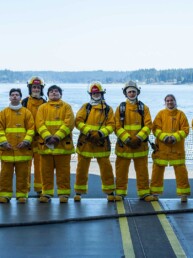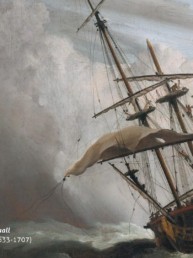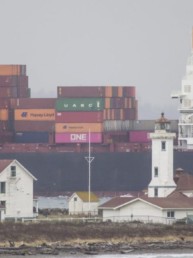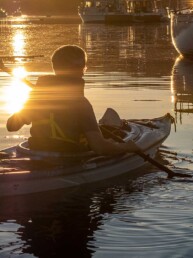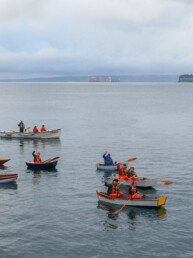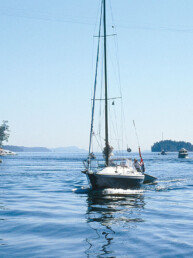Looking out the window on the plane home to Alaska, Porter catches my eye while thumbing through the contents in the seat pocket in front of him. I don’t say a word, yet I’m curious as to what he finds interesting. Within seconds he pulls the safety card out onto his lap, holds it up and says, “I’ve gotta read this, Dad. You know how much I love safety.” Shaking my head in laughter, I can only agree. What a sailor.

A bit later he turns to me again and, still on the safety thing, starts up a conversation about PFDs. He tells me that he wears his all the time on the dock and on the boat, and that I wear mine in the dark or in bad weather. True enough.
Then, when our chat extends into harnesses, tethers and night sailing, I slowly realize he’s recalling a discussion he listened to my dad and I have the day before in Seattle. I tell ya, the boy doesn’t let anything get by, and he knows safety is always a priority on our boat and others. Lately, it has been about others.
Being in Seattle last weekend for the boat show was a whirlwind of presentations, work meetings and catching up with many dear friends. (Sorry to those I missed!) But it was also a chance for me to work on issues related to two big sailing events I’m participating in this summer: the 750-mile Race to Alaska (R2AK), and the 333-mile freshwater classic, Chicago to Mackinac Race.
Each race presents a unique set of challenges with navigation, weather, crew and the boat, yet the principles of seamanship and safety remain the same — keep the water out of the boat, keep the people in the boat, and don’t hit anything.
Skippering the Mac with my dad alongside, and Jill and my siblings also aboard, means that I’ve got a crew of seven to account for and a boat to equip with adequate gear, knowledge and experience. With my dad in town for the show, we sat down and went through a number of items that we need to get done, made lists and even got to cross some things off those lists. Safety was given top priority and we made some key decisions at Fisheries Supply. The first of which was easy — buy the Standard Horizon HX870 as a supplement to our onboard radios.

I’ve probably talked about the HX870 before when Jill and I were fitting out Yahtzee for Swiftsure and the Oregon Offshore Race, but this handheld is a work of art. Also, it, or something similar, is a requirement for many offshore sailing events and we’ll have a couple aboard Team Wild Card for the R2AK. Key features include 66-channel WAAS GPS receiver, DSC calling, position sharing, waypoint and route navigation, navigation to a DSC distress call and a whole lot more. If you’re in the market for a handheld, this is the only option.
Our next move was to outfit the boat with new inflatable PFDs and tethers. I’ve looked at a lot of PFDs over the years and am continually impressed with what is on the market. What I haven’t been impressed with is how my old West Marine inflatable has fit compared to new models, particularly when I went into the pool during a Safety at Sea Seminar.

During our search for new life jackets we were looking to strike a balance between quality, comfort and price (since we’re buying seven), and I think we found it in the CrewSaver ErgoFit 40. A comfortable jacket will be worn and, thus, will be safe, and this particular jacket is a jump up in comfort from the suspender type. It is also clutter free and seems to allow for a good amount of mobility. And of utmost importance, it has a built in harness and automatically inflates when it is submerged. Porter will be happy to know that I’ll be wearing this one from now on aboard Yahtzee, and during this summer’s races.
The next piece of gear we decided on was another relatively easy one: jacklines. They’re a must for both races and I’ve used various styles and setups over the years for offshore sailing. But recently I came across the Wichard Lyf’Safe jacklines, which come in a kit with two lengths of webbing and then two tension adjusters with glow-in-the-dark covers. They are available in 27-, 36- and 46-foot lengths, and the adjusters make it quick and easy to set them up snuggly and safely where you want them.

“Where we want them” is something I’ve been contemplating a lot over the last couple years, though. I’ve never been a big fan of side deck jacklines and have been rigging Yahtzee’s farther inboard towards the mast to keep crew more centrally located. But my friends John Neal and Amanda Swan Neal turned me on to rigging the jacklines at waist or chest level — which I see the merits of but have yet to try — so we’ll need to figure out what works best during shakedown sails for each race.
As you can tell, we’re still thinking through a lot of safety options for the R2AK and Mac race boats and are always looking to improve — so stay tuned!
Andy Cross
Andy Cross is the editor of 48° North. After years cruising the Pacific Northwest and Alaska with his family aboard their Grand Soleil 39, Yahtzee, they sailed south and are currently in the Caribbean Sea. You can follow their adventures at SailingYahtzee.com.

